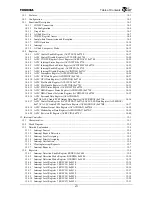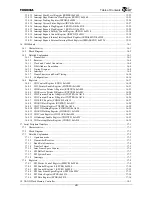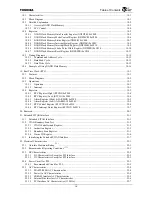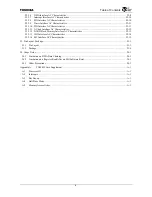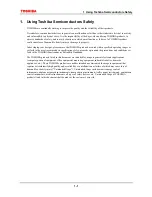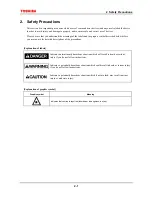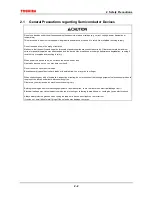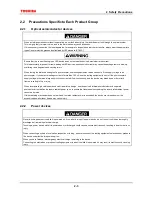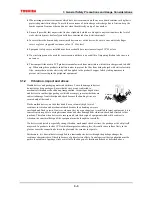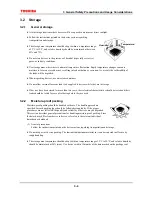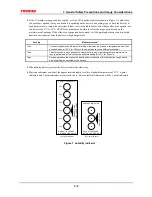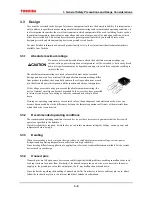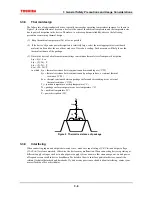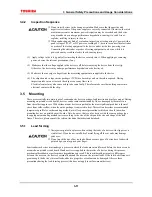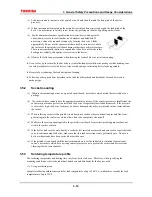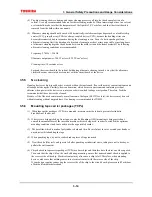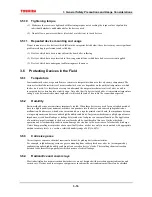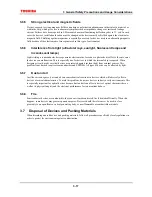
3 General Safety Precautions and Usage Considerations
3-2
(e) Make sure that sections of the tape carrier which come into contact with installation devices or other
electrical machinery are made of a low-resistance material.
(f) Make sure that jigs and tools used in the assembly process do not touch devices.
(g) In processes in which packages may retain an electrostatic charge, use an ionizer to neutralize the ions.
•
Make sure that CRT displays in the working area are protected against static charge, for example by a VDT
filter. As much as possible, avoid turning displays on and off. Doing so can cause electrostatic induction in
devices.
•
Keep track of charged potential in the working area by taking periodic measurements.
•
Ensure that work chairs are protected by an anti-static textile cover and are grounded to the floor surface by a
grounding chain. (Suggested resistance between the seat surface and grounding chain is 7.5
×
10
5
to 10
12
Ω
.)
•
Install anti-static mats on storage shelf surfaces. (Suggested surface resistivity is 10
4
to 10
8
Ω
/sq; suggested
resistance between surface and ground is 7.5
×
10
5
to 10
8
Ω
.)
•
For transport and temporary storage of devices, use containers (boxes, jigs or bags) that are made of anti-static
materials or materials which dissipate electrostatic charge.
•
Make sure that cart surfaces which come into contact with device packaging are made of materials which will
conduct static electricity, and verify that they are grounded to the floor surface via a grounding chain.
•
In any location where the level of static electricity is to be closely controlled, the ground resistance level
should be Class 3 or above. Use different ground wires for all items of equipment which may come into
physical contact with devices.
(2) Operating
environment
•
Operators must wear anti-static clothing and conductive shoes (or a leg or
heel strap).
•
Operators must wear a wrist strap grounded to earth via a resistor of about
1 M
Ω
.
•
Soldering irons must be grounded from iron tip to earth, and must be used only at low voltages (6 V to 24 V).
•
If the tweezers you use are likely to touch the device terminals, use anti-static tweezers and in particular avoid
metallic tweezers. If a charged device touches a low-resistance tool, rapid discharge can occur. When using
vacuum tweezers, attach a conductive chucking pat to the tip, and connect it to a dedicated ground used
especially for anti-static purposes (suggested resistance value: 10
4
to 10
8
Ω
).
•
Do not place devices or their containers near sources of strong electrical fields (such as above a CRT).
Summary of Contents for TMPR4925
Page 1: ...64 Bit TX System RISC TX49 Family TMPR4925 Rev 3 0 ...
Page 4: ......
Page 15: ...Handling Precautions ...
Page 16: ......
Page 18: ...1 Using Toshiba Semiconductors Safely 1 2 ...
Page 40: ...3 General Safety Precautions and Usage Considerations 3 18 ...
Page 42: ...4 Precautions and Usage Considerations 4 2 ...
Page 43: ...TMPR4925 ...
Page 44: ......
Page 54: ...Chapter 1 Features 1 8 ...
Page 58: ...Chapter 2 Block Diagram 2 4 ...
Page 88: ...Chapter 4 Address Mapping 4 12 ...
Page 226: ...Chapter 8 DMA Controller 8 58 ...
Page 260: ...Chapter 9 SDRAM Controller 9 34 ...
Page 480: ...Chapter 15 Interrupt Controller 15 32 ...
Page 554: ...Chapter 19 Real Time Clock RTC 19 8 ...
Page 555: ...Chapter 20 Removed 20 1 20 Removed ...
Page 556: ...Chapter 20 Removed 20 2 ...
Page 564: ...Chapter 21 Extended EJTAG Interface 21 8 ...
Page 580: ...Chapter 22 Electrical Characteristics 22 16 ...
Page 588: ...Chapter 24 Usage Notes 24 2 ...


